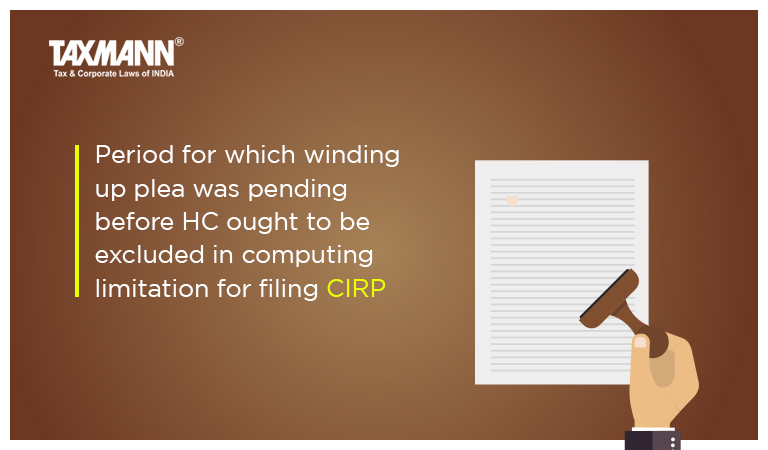Period for which winding up plea was pending before HC ought to be excluded in computing limitation for filing CIRP
- Blog|News|Insolvency and Bankruptcy Code|
- 2 Min Read
- By Taxmann
- |
- Last Updated on 16 September, 2022
Case Details: Brandbaron Marketing (P.) Ltd. v. Times Internet Ltd. - [2022] 142 taxmann.com 57 (NCLAT-New Delhi)
Judiciary and Counsel Details
-
- Justice Ashok Bhushan, Chairperson & Dr Alok Srivastava, Technical Member
- Sanjeev Kumar, Adv. for the Appellant.
- Krishnendu Datta, Sr. Adv. & Manish Kumar Srivastava, Adv. for the Respondent.
Facts of the Case
In the instant case, the appellant-operational creditor entered into an agreement with ‘T’, as a service provider. Thereafter ‘T’, to whom services were provided by the appellant, was merged with the respondent – corporate debtor. The appellant filed a winding up petition against the respondent – corporate debtor. However, the said petition was dismissed by the High Court.
Consequently, after the dismissal of the winding up petition, the appellant issued a notice to the corporate debtor claiming its outstanding amount. In reply to the said notice, the corporate debtor denied the outstanding claim of the appellant. Thereafter, the appellant filed an application u/s 9 of the IBC before the Adjudicating Authority (NCLT).
The National Company Law Tribunal (NCLT) dismissed the said application on the ground that the application filed by the appellant was time-barred. Then, an appeal was filed to the National Company Law Appellate Tribunal (NCLAT) against the order passed by the NCLT.
The appellant claimed that the Adjudicating Authority committed an error in rejecting the application u/s 9 of the IBC as time-barred. Further, the appellant claimed that while dismissing the winding up petition, the High Court itself had granted liberty to proceed against the real entity i.e. the corporate debtor.
The NCLAT observed that the winding up petition stood dismissed since the real entity, i.e. ‘TI’, with whom ‘T’ was merged was neither noticed nor impleaded in the winding up petition. No statutory notice having been sent to the ‘TI’, the winding up petition was dismissed. Thus, the winding up petition stood dismissed due to the defect of procedure as noticed in the judgment of the High Court of Delhi.
NCLAT Held
The NCLAT held that the appellant had made out a sufficient cause for condonation of delay in filing section 9 application and the period during which winding up petition was pending before the High Court ought to be excluded in computing the period of limitation within the meaning of section 14(2) of the Limitation Act, 1963.
List of Cases Reviewed
-
- Order of NCLT (New Delhi) in IB-437/ND/2020, dated 14-10-2021 (para 23) reversed.
- Roshanlal Khuthalia v. R.B. Mohan Singh Obrai [1975] 4 SCC 628
- Union of India v. West Coast Paper Mills Ltd. [2004] 3 SCC 458
- Consolidated Engineering Enterprises v. Principle Secretary, (Irrigation Department) [2008] 7 SCC 169
- Sesh Nath Singh v. Baidyabati Sheoraphuli Co-operative Bank Ltd. [2021] 125 taxmann.com 357/166 SCL 507 (SC) (paras 17, 18, 19 and 21) followed.
List of Cases Referred to
-
- Roshanlal Khuthalia v. R.B. Mohan Singh Obrai [1975] 4 SCC 628 (para 17)
- Union of India v. West Coast Paper Mills Ltd. [2004] 3 SCC 458 (para 18)
- Consolidated Engineering Enterprises v. Principle Secretary, (Irrigation Department) [2008] 7 SCC 169 (para 19)
- Sesh Nath Singh v. Baidyabati Sheoraphuli Co-operative Bank Ltd. [2021] 125 taxmann.com 357/166 SCL 507 (SC) (para 21).
Disclaimer: The content/information published on the website is only for general information of the user and shall not be construed as legal advice. While the Taxmann has exercised reasonable efforts to ensure the veracity of information/content published, Taxmann shall be under no liability in any manner whatsoever for incorrect information, if any.

Taxmann Publications has a dedicated in-house Research & Editorial Team. This team consists of a team of Chartered Accountants, Company Secretaries, and Lawyers. This team works under the guidance and supervision of editor-in-chief Mr Rakesh Bhargava.
The Research and Editorial Team is responsible for developing reliable and accurate content for the readers. The team follows the six-sigma approach to achieve the benchmark of zero error in its publications and research platforms. The team ensures that the following publication guidelines are thoroughly followed while developing the content:
- The statutory material is obtained only from the authorized and reliable sources
- All the latest developments in the judicial and legislative fields are covered
- Prepare the analytical write-ups on current, controversial, and important issues to help the readers to understand the concept and its implications
- Every content published by Taxmann is complete, accurate and lucid
- All evidence-based statements are supported with proper reference to Section, Circular No., Notification No. or citations
- The golden rules of grammar, style and consistency are thoroughly followed
- Font and size that’s easy to read and remain consistent across all imprint and digital publications are applied








 CA | CS | CMA
CA | CS | CMA


